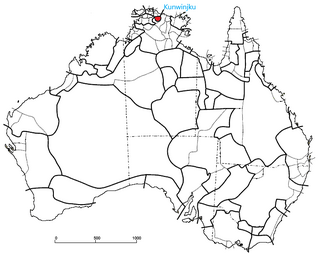Name
In the dreamtime legends of this area, a woman, Imberombera and a man, Wuraka, are foundational figures. They came to the mainland separately by walking southwards across the sea, and Imberombera landed at Malay Bay (Wungaran). Both originally spoke Iwaidja. She encounter Wuraka and wished him to accompany her, but Wuraka, tired by the burden of his heavy penis, which he carried slung over his shoulder, demurred. Imerombera pressed on, heavily pregnant, and on her journey, left spirit children at various points, together with yams, or cyprus bulbs or bamboo, and chanted the language to be spoken in each area. In what became Puneitja ground, she said: Puneitja ngeinyimma tjikaru, gnoro Jaijipali, the first word indicating the language.
Airiman were an Indigenous Australian tribe from Australia's Northern Territory.
The Amurdak, people, also written Amarak and Ngamarak, are an indigenous Australian people of the Cobourg Peninsula in the Northern Territory.

The Gunwinggu (Kunwinjku) people are an Australian Aboriginal people, one of several groups within the Bininj people, who live around West Arnhem Land to the east of Darwin, Northern Territory. Kunwinjku people generally refer to themselves as "Bininj" in much the same way that Yolŋu people refer to themselves as "Yolŋu".
The Binbinga, also pronounced Binbinka, are an Indigenous Australian people of the Northern Territory of Australia.
The Garrwa people, also spelt Karawa and Garawa, are an Aboriginal Australian people living in the Northern Territory, whose traditional lands extended from east of the McArthur River at Borroloola to Doomadgee and the Nicholson River in Queensland.
The Djowei are an indigenous Australian people of the Northern Territory.
The Awarai (Warray) are an indigenous Australian people of the Northern Territory.
The Yukul, also written Jukul, were an indigenous Australian people of the Northern Territory.
The Mangarayi, also written Mangarai, were an indigenous Australian people of the Northern Territory.
The Bingongina or Pinkangarna are a possible indigenous Australian people of the Northern Territory. However, the name may simply be a former alternative term for Mudburra.
The Widi were an indigenous Australian people of the Mid West region of Western Australia.
The Ngarinman or Ngarinyman people are an Aboriginal Australian people of the Northern Territory who spoke the Ngarinyman language.
The Alura were an indigenous Australian people of the Northern Territory.
The Wilingura otherwise known as the Wilangarra, were an indigenous Australian people of the Northern Territory.
The Watta were an indigenous Australian people of the Northern Territory.
The Ngardok were an indigenous Australian people of the Northern Territory. Nothing is known of the language, which has been extinct since about WW2.
The Gaagudju, also known as the Kakadu, are an Aboriginal Australian people of the Northern Territory.
The Gudanji, otherwise known as the Kotandji or Ngandji, are an indigenous Australian people of the Northern Territory.
The Ngormbur were an indigenous Australian people of the Northern Territory.
The Norweilemil were an indigenous Australian people of the Northern Territory.
This page is based on this
Wikipedia article Text is available under the
CC BY-SA 4.0 license; additional terms may apply.
Images, videos and audio are available under their respective licenses.
